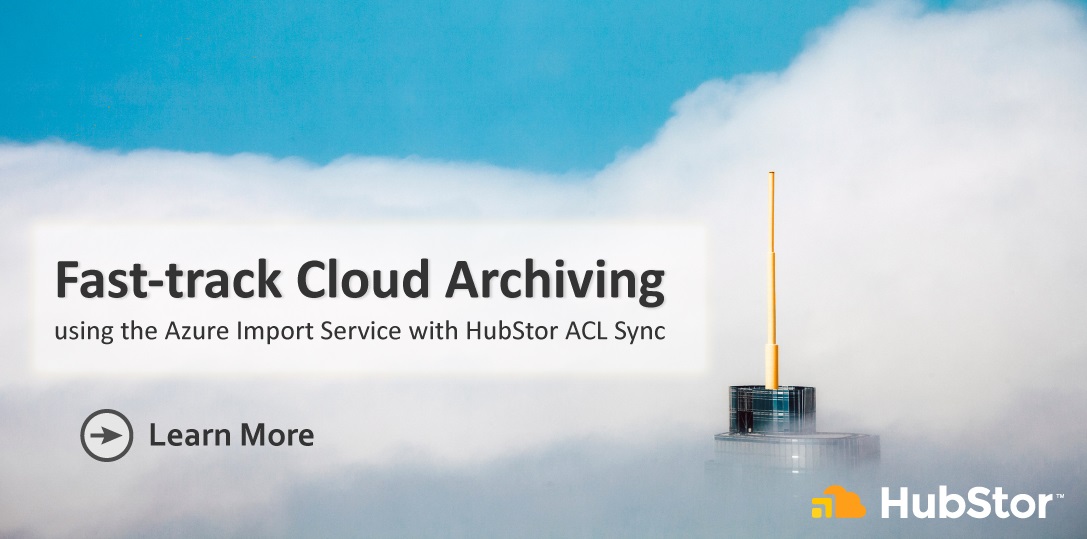Clients can now leverage both policy-based data migration and drive shipping with ACL synchronization.
HubStor now supports the drive shipping method of ingestion using the Azure Import/Export Service from Microsoft. And, HubStor uniquely lets you sync up the original metadata and permissions with the drive-shipped data. It is a convenient means of getting legacy data volumes into HubStor without impacting your network bandwidth, and without losing the original access rights, ownership, and file attributes when you copy the data for shipping.
To leverage this, you simply use the Azure Import/Export Service as it is designed. There is a low-cost per drive regardless of how much data a drive contains. The drive shipping process is between you and Microsoft. Full details of the process can be found here: https://docs.microsoft.com/en-us/azure/storage/storage-import-export-service
Upon receiving your drives, Microsoft loads the content into a blob storage account and return ships the drives. When Microsoft notifies you that your drives have been loaded, you then need to notify HubStor. In Azure, we will configure an instance of the HubStor Connector Service to migrate those blobs into your HubStor tenant.
Then, if you want the original access rights and file metadata to be synced with your drive-shippped content, HubStor will work with you to run your on-premises instance of the HubStor Connector Service in a special mode against the original data. Of course, this requires the content you drive-shipped to be network mounted on-premises so that HubStor can crawl it in its original state to scrape permissions and other metadata. HubStor will seamlessly associate the source metadata with blobs in your HubStor tenant. In this scenario, it is only metadata that is transferred over your network connection.
We have a one-page overview of the process which you can download here. If you are interested in using the drive-shipping service with HubStor, please let us know by emailing support.
Deciding Which Method to Use
With HubStor, you have the best of both worlds: 1) Drive-shipping with ACL sync, and 2) Optimized data migration over the network. So, how do you decide which approach to use?
The default approach which all HubStor clients use is the automated, policy-driven data migration over the network using the HubStor cloud gateway software (aka. the ‘HubStor Connector Service’). This software allows you to migrate select datasets in place from your SAN/NAS to the cloud using policies over the network. Data is compressed before sending, encrypted in motion, and you can throttle the bandwidth impact during peak and off-peak hours. This method is ideal when you are tiering/archiving a workload where there is a steady stream of new data that becomes low-touch or inactive within a few weeks. It is also ideal when you want to use HubStor’s seamless storage tiering capabilities to make your existing file servers behave like cloud storage gateways. And it offers the ability to selectively encrypt data-at-rest before sending it to the cloud so that only you have the key.

Drive shipping is a great way to expedite the process of migrating your legacy data to the cloud. It is ideal when you have large workloads to be archived and you wish to avoid impacting your network with a lengthy data transfer project. Workloads might be data from a retired application, content from backup tapes, ex-employee data, or old project data that is required for long-term preservation.
In the drive shipping method, if you want access control lists (ACLs) to be consistent with your data in the cloud, HubStor’s virtual cloud gateway plays a role here too. After the drive-shipped data is ingested into HubStor, the virtual cloud gateway crawls the data in your environment to scrape the metadata and sync it to the cloud alongside the blobs that are already there. In this process, the virtual cloud gateway is not transferring blobs; just the metadata.

Both data migration methods can be used in parallel.
If you are interested in using the drive-shipping service with HubStor, please let us know by emailing support.
Download the data sheet for more information.



